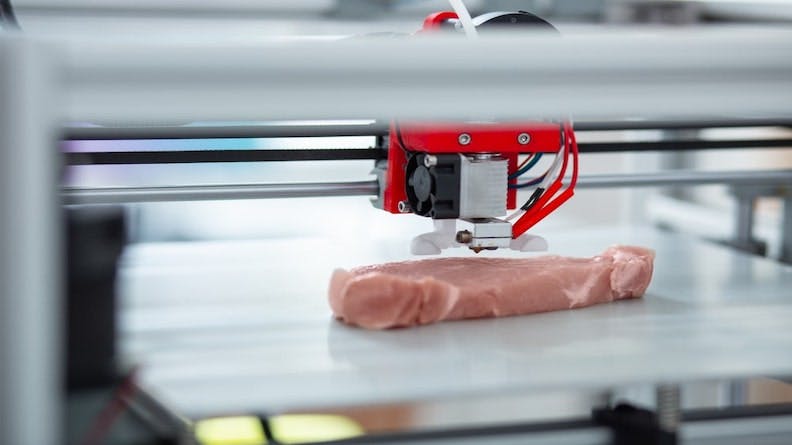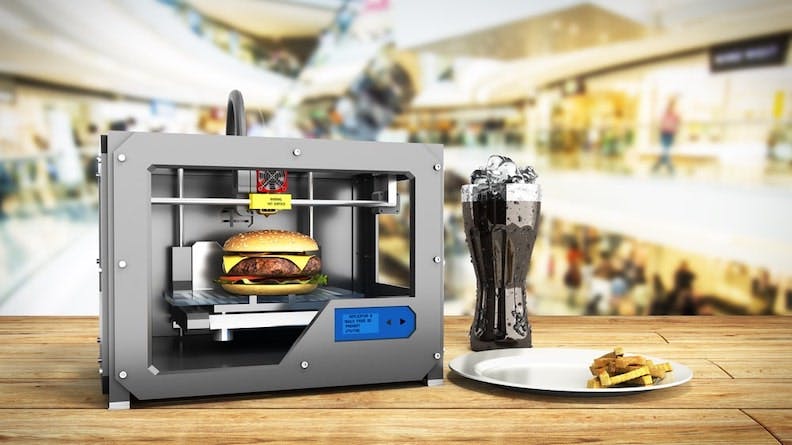
3D Printing in the Food Industry: History, Benefits, Materials, and Examples
Learn more about this niche use of 3D printing technology.

3D Printing in the Food Industry: History, Benefits, Materials, and Examples
3D-printed food was developed to create interesting food designs. It also attempted to revolutionize the food production process by creating food efficiently and at a lower cost. 3D food is still a relatively small niche market and has not progressed to be a widely used food production method. 3D printing food was first developed in 2006. It has since branched out into many different applications and technologies. Typical constituents include powdered ingredients like sugar, meltable materials like chocolate or cheese, and dough or mash. 3D-printed meat is also being developed that makes use of either plant-based proteins or cultured animal cells.
This article will explore 3D-printed food and discuss common ingredients and technologies used while also highlighting some key examples.
What Is 3D Printing in the Food Industry?
3D printing in the food industry refers to the process of creating foods using 3D printing technology. The most commonly used technology makes use of food ingredients that are relatively viscous to ensure that, when extruded, the material keeps the intended form. The food is built up layer by layer until complete. 3D printers do not cook the food, but rather prepare them in the desired form. Thereafter, they may need to be cooked in an oven after the printing process is complete. Some foods, like sugar or chocolate, can be consumed directly after printing.
For more information, see our guide on Everything You Need to Know About 3D Printing.
What Was the First 3D-Printed Food?
The first 3D-printed foods were:
- Chocolate: Chocolate needs to be kept in a liquid form. It cools quickly after extrusion, making it an ideal food for 3D printing.
- Cheese: Like chocolate, cheese must be held in its molten form prior to extrusion. It also tends to cool relatively quickly.
- Cookie Dough: Cookie dough is a paste that can be easily extruded into the required shape. However, the cookie must be baked in an oven after printing before it can be consumed.
Who Was the First To Use 3D Printing in Food?
3D printing of food was first used by the hobbyist 3D printing movement. A team at Cornell University’s Mechanical and Aerospace Engineering Department developed the Fab@Home 3D printer in 2006. This was one of the first open-source 3D printers. The Fab@Home 3D printer was a multi-material machine that used precisely controlled syringes to deposit material. It was able to print chocolate, cookie dough, and cheese.
What Are the Benefits of 3D-Printed Food?
The benefits of 3D printing food are listed below:
- Automation: 3D printing allows for the automation of the food preparation process. The machine can be left to build the food while other portions of the meal are prepared.
- Precise Ingredient Control: 3D food printers make use of precisely controlled stepper motors to dispense ingredients. This means that consistent ingredient accuracy is maintained while also reducing overall waste.
- Creativity: 3D printing allows for unmatched creativity. Complex 3D food products with impressive geometries can be created that would be impossible to construct by hand.
- Customizable Foods: Food products can be easily customized depending on a consumer's preferences. This can be as simple as changing the ratio of ingredients used to make the product by changing the deposition settings on the machine. Alternatively, the ingredient pods can be swapped out for different ingredient combinations.
What Ingredients Are Suitable for 3D food?
The range of ingredients for 3D-printable foods is constantly increasing. Listed below are some of the more commonly used ingredients:
- Sugar: Different types of sugar like icing and castor sugar can be successfully 3D printed. Binder jetting is a frequently used method.
- Cake Icing: Decorating cakes with icing is a prime application for food-based 3D printing. Complex designs can be achieved with minimal effort.
- Dough: The correct balance of ingredients needs to be achieved in order to ensure optimal consistency when printing with dough. Pizza crust doughs can be easily printed.
- Hydrocolloid Systems: These are xanthan gum and gelatin-based ingredients. Flavors are mixed in to enhance the taste. These raw materials can be extruded while cold.
- Colored Food Ink: Food inks can be used to enhance existing food products. The ink is placed onto the food using an inkjet style printing technology.
- Cultured Meat: Meat cells can be printed using an inkjet style process. Both meat and fat cells can be used to create food that appears and tastes like meat without the potential moral implications of real meat.
- Chocolate: Chocolate is melted and then deposited onto the build platform. Chocolate must be extruded hot and given enough time to cool and harden.
- Cheese: Cheese can be printed in molten form. An extrusion-style process is typically used. In this case, the cheese is still more viscous than (for example) chocolate. But it can still be extruded albeit with a larger nozzle.
- Mashed Potatoes: Mashed potato has the perfect consistency for extrusion-based printing. However, mashed potatoes are difficult to remove from the build platform without breaking up the intended shape.
What Is 3D Printer Food Made Of?
Typical 3D-printable foods are made of chocolate, cheese, and powdered ingredients like sugar or flour. Simulated meat, as well as cultured meat, are also possibilities. Currently, 3D-printed food is only a novelty that can be used to accompany existing meals. The types of foods that can be 3D printed are generally limited by the available 3D printing technologies. This is why powdered, meltable, and paste-like ingredients are typically used.
What Type of 3D Printer Is Used in 3D Food?
3D printing technologies for food printing closely match their plastic-based counterparts. The main types of 3D printers used for food are listed below:
- Extrusion: Works similarly to an FDM (Fused Deposition Modeling) 3D printer for plastics. However, instead of an extruder and a hot end (a component of an FDM 3D printer), a food-filled syringe is used to dispense the ingredients. Some popular machine suppliers are Natural Machine, Foodini, and byFlow.
- Binder Jetting: Binder jetting works by laying down a powder ingredient and then spraying an edible liquid binder on top of the powder to fuse the food particles together. 3D Systems and Brill 3D Culinary Studio both produce binder-jetting 3D food printers for creating powder-based food products.
- Inkjet: An edible liquid is dispensed using multiple inkjet heads. Applications include edible decorative images or bio-ink for cultured meat printing. MeaTech is currently developing an advanced inkjet food printer for producing cultured meat products.
What Materials Are Used in 3D Printing Food?
Food-safe materials must be used that are in contact with the ingredients and the finished products. Materials that can be sterilized either chemically or at high temperatures are required. This is because 3D printers that produce food must adhere to stringent food-safety guidelines. Stainless steel and food-safe plastics like ABS, polypropylene, or acrylics are therefore used to make the machinery for 3D food-printing applications.
What Are Examples of 3D-Printed Food?
Examples of 3D-printed foods are:
- Cultured Meat: Animal cells are cultured in a stem-cell-based bioreactor without harming the animals. They are then printed with an inkjet-style food printer. An example of 3D-printed meat is the offering from Aleph Farms. Figure 1 below shows a 3D-printed rib-eye steak:
Close up of a 3D printer recreating a piece of meat.
Image Credit: Shutterstock.com/Dmytro Zinkevych
- Meat Substitutes: Meat substitutes are made from plant proteins extracted from peas and soybeans. Redefine Meat is a pioneer in this field. An example of their plant-based meat is shown in Figure 2:
3D printed burger.
Image Credit: Shutterstock.com/NosorogUA
- Chocolate: Chocolate is one of the easiest materials to 3D print since it can be melted and re-solidified relatively quickly. Intricate chocolate shapes can be made, as shown in Figure 3 below:
3D printed chocolate cups.
Image Credit: Shutterstock.com/Oleksandr Yuchynskyi
- Pasta: Complex fresh pasta designs can be printed to create unique culinary experiences. Currently, the Barilla Pasta Printing Machine itself is not available for purchase by consumers. Only the pasta designs can be purchased. One such design is shown in Figure 4 below:
3D printed pasta.
Image Credit: www.3dnatives.com
How Does 3D Printing Food Work?
There are many different methods of 3D printing food. The most common is FDM-style printing. This process works by placing an ingredient into a syringe-type dispenser. The food printer then moves the head of this dispenser around the build plate, tracing out the cross-section of the food one layer at a time, until it is complete. In some cases, the food needs to be cooked afterward.
How Long Does It Take To Print 3D Food?
3D printing of foods is significantly quicker compared to printing methods for non-food materials. This faster pace is primarily due to the thicker layers that can be printed due to the highly viscous nature of the ingredients. In addition, there is no real need for the geometric accuracy common with engineering applications. Completing one 3D printed food item can take from 7 to 45 minutes, depending on the complexity of the product design. Post-print cooking can significantly extend the total production time.
Is 3D-Printed Food Edible?
Yes, 3D-printed food is edible. It is made from edible ingredients. Commercial 3D-printed foods must adhere to the same health and safety requirements as all other foods offered for sale to consumers.
Is 3D-Printed Food Safe?
Yes, 3D-printed food is safe, provided that applicable food-handling regulations are observed and it is prepared on clean equipment using fresh ingredients.
Summary
This article reviewed the use of 3D printing technology in the food industry. To learn more about the 3D printing of food and how it can be applied successfully to your projects, contact a Xometry representative.
Xometry provides a wide range of manufacturing capabilities including 3D printing and value-added services for all of your prototyping and production needs. Visit our website to learn more or to request a free, no-obligation quote.
Disclaimer
The content appearing on this webpage is for informational purposes only. Xometry makes no representation or warranty of any kind, be it expressed or implied, as to the accuracy, completeness, or validity of the information. Any performance parameters, geometric tolerances, specific design features, quality and types of materials, or processes should not be inferred to represent what will be delivered by third-party suppliers or manufacturers through Xometry’s network. Buyers seeking quotes for parts are responsible for defining the specific requirements for those parts. Please refer to our terms and conditions for more information.




